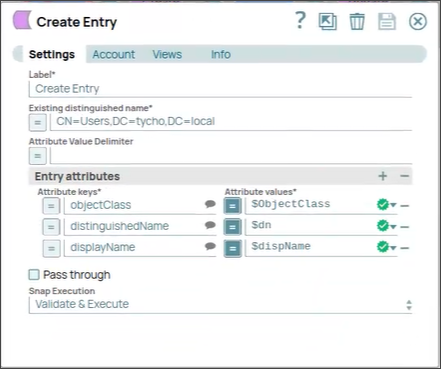Active Directory Create Entry
On this Page
Snap type: | Write | |||||||
|---|---|---|---|---|---|---|---|---|
Description: | This Snap is used to create an entry in Active Directory. An entry (user Account) can be created in any Organizational Unit (OU), Domain Controller (DC) and so on by providing the complete distinguished name which is what LDAP uses to uniquely identify an LDAP object. The attributes of table will create on suggest based on the existing entry into Active Directory. The table consists of all the fields that need to be generated when the entry is created. Many of the attributes may be mandatory when creating an entry depending on the configuration of the AD instance. Here are some example fields: objectClass, distinguished name which are required. To generate the suggested attributes into the table, the distinguished name of the existing entry into Active Directory is required.
| |||||||
| Prerequisites: | [None] | |||||||
| Support and limitations: | Works in Ultra Tasks. | |||||||
| Account: | This Snap uses account references created on the Accounts page of SnapLogic Manager to handle access to this endpoint. See Active Directory Basic Auth Account for information on setting up this type of account. | |||||||
| Views: |
| |||||||
Settings | ||||||||
Label | Required. The name for the Snap. You can modify this to be more specific, especially if you have more than one of the same Snap in your pipeline. | |||||||
Existing distinguished name | Required. The distinguished name of the existing entry. To generate the suggested attributes in the table, the distinguished name of the existing entry into Active Directory is required. The LDAP API references an LDAP object by its distinguished name (DN). A DN is a sequence of relative distinguished names (RDN) connected by commas. An RDN is an attribute with an associated value in the form attribute=value, normally expressed in a UTF-8 string format. The typical RDN attribute types include: DC = domainComponent, CN = commonName, OU = organizationalUnitName,O = organizationName, STREET = streetAddress, L = localityName,ST = stateOrProvinceName, C = countryName, UID = userid. This field is applicable only to existing users. If a user does not exist, you can create the distinguished name manually from the Active Directory server to create a new user using Active Directory Create Entry Snap. Or, by default, the server creates system users when creating the domain space, which you can use as a reference for Existing distinguished name. Example: A distinguished name for an LDAP entry can be represented as: CN=AbcUser,CN=Users,DC=server,DC=company,DC=com. In this example, to refer to the entire user list, you can remove the initial attribute, CN=AbcUser. Default value: [None] You can also use special characters in the distinguished name. See the section Using Special Characters in Distinguished Name below. | |||||||
| Attribute Value Delimiter | Character or string to be used as delimiter to separate multiple values provided to the Attribute Value field. Example: Default value: [None] | |||||||
| Entry attributes | Required. The table of suggested attribute key-value pairs to create the entry. Consists of two fields:
| |||||||
| Attribute Keys | Required. Attribute keys to create the entry. Some of the attribute keys and its values may require to create the entry. For example: Default value: [None] | |||||||
| Attribute Values | Required. Value of the attribute. Its expression. Some of the attribute values corresponding to their keys require to create the entry For example: value of the key objectClass as 'top, user, organizationalPerson' and the value of the key DistinguishedName as 'CN=SomeUser, CN=Users, DC=child, DC=parent, DC=Domain, DC=com'. Space is considered to be string in attribute, when using multi value attribute. Default value: [None] | |||||||
| Pass through | Select to include the entire input data in the Snap's output. The Snap includes this data within the $original field in the output. Default value: Not selected | |||||||
Snap execution | Select one of the three modes in which the Snap executes. Available options are:
| |||||||
Using Special Characters in Distinguished Name
You can include special characters in the Distinguished name and Existing distinguished name fields. As of Patch activedirectory8789, the fields do not require the following special characters to be prefixed with an escape character:
Forward slash (/)
Backward slash (\)
Plus (+)
Double-quote (")
Less than symbol (<)
Greater than symbol (>)
Semi-colon (;)
Downloads
Important steps to successfully reuse Pipelines
- Download and import the pipeline into the SnapLogic application.
- Configure Snap accounts as applicable.
- Provide pipeline parameters as applicable.
Snap Pack History
Have feedback? Email documentation@snaplogic.com | Ask a question in the SnapLogic Community
© 2017-2025 SnapLogic, Inc.
